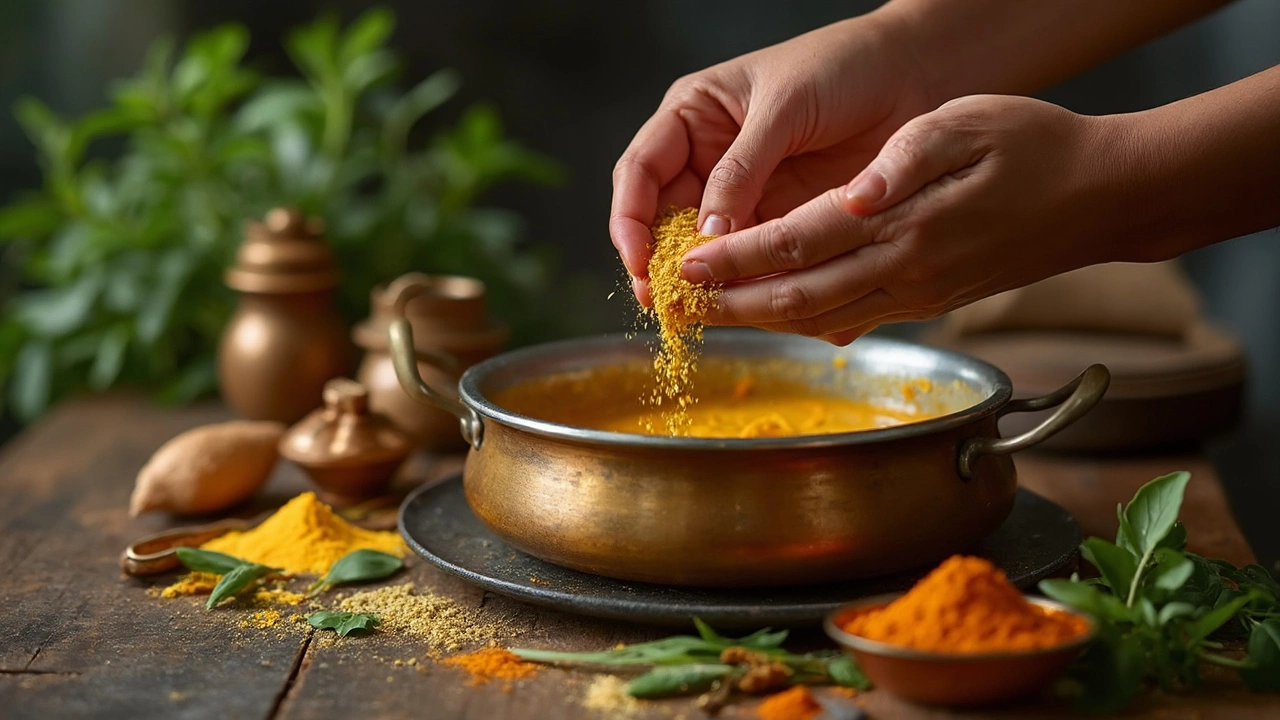Why Does Dal Make Me Gassy? The Science Behind Legume Bloating and Easy Fixes
 Jun, 23 2025
Jun, 23 2025
If you've ever tucked into a hearty bowl of dal and ended up shifting awkwardly on the sofa because your belly feels like it's got a beach ball inside, you're definitely not alone. For loads of us here in Australia (and honestly, pretty much everywhere dal is eaten), that familiar, bloated feeling after a dal-heavy meal can be a real struggle. It's like your favourite comfort food is playing a prank on you. Ever catch yourself thinking, 'Why does eating dal turn my stomach into a wind tunnel?' You're not imagining things—there's solid science behind it, but there's also loads you can do to reclaim your dinner and your dignity.
What's Really Going On When Dal Makes You Gassy?
The star ingredient in dal, whether it's moong, masoor, chana, or toor, is basically just a legume. Legumes are nutritional powerhouses, loaded with protein, fibre, complex carbs, vitamins, and minerals. Sounds like nothing could go wrong, right? But here's the tricky part: legumes, including dal, also pack certain complex sugars called oligosaccharides. Humans simply don't have the tools (or more accurately, the enzymes) in their small intestine to break these down.
Fast forward to your large intestine. That’s where all the magic—or should I say mayhem—happens. Anything you couldn't digest upstairs gets sent down to your colon, where trillions of bacteria are just waiting for their moment in the spotlight. These bacteria go to town on those undigested oligosaccharides, fermenting the daylights out of them. And what’s the byproduct? Gas. Think hydrogen, methane, and sometimes even a little carbon dioxide. The more dal you eat, the more fuel there is for these microbes, which means more gas gets produced. Simple math, really.
Some people have a full-on gaseous symphony; others barely notice a toot. That comes down to your personal gut bacteria cocktail, your usual fibre intake, and how much dal you've packed into your bowl. Here’s a fact: studies from Australia’s CSIRO have shown that up to 30% of the adult population reports increased bloating and wind after meals rich in legumes. So you’re in good company!
The fibre in dal (think both soluble and insoluble) is another double-edged sword. It slows down digestion, which means you feel full for longer, but it also gives those gut bacteria even more time to feast on leftovers and do their gassy handiwork. It’s like they get to enjoy a nice slow-cooked stew, and unfortunately, you’re the slow cooker.
Here’s an interesting tidbit: a small part of that gassy aftermath also comes from your body handling other minerals in dal, like iron and magnesium, which can affect everything from water retention to your gut motility. But the main player here—no question—is that fermentation by your gut bacteria. If you’re new to a plant-heavy diet or you’ve just gotten into dal, your gut’s probably not used to all this fibre and resistant starch, so it kind of goes haywire until it adapts.
To put numbers to it, a typical serving of dal (about a cup cooked) can have around 15 grams of fibre and 6-8 grams of oligosaccharides. High-protein and high-fibre foods like dal are famous for their health perks, but with great power comes great responsibility… or, in this case, great farts.
| Dal Type | Fibre (per 1 cup, cooked) | Oligosaccharides Content* |
|---|---|---|
| Toor Dal | 13g | 7g |
| Moong Dal | 14g | 5g |
| Chana Dal | 16g | 9g |
| Masoor Dal | 15g | 8g |
*Oligosaccharides estimate varies based on soaking and cooking methods.

Why Some People Get More Bloated Than Others
Notice how your mate Bob can eat double the dal and barely burp, but you feel like you need to open a window? It’s not your imagination—everyone's gut is different. Your bacteria, your genetics, your enzyme production, and your overall diet all play into this.
Let’s start with gut bacteria. Your personal collection—sometimes called your “microbiome”—is like a fingerprint. If you’re used to a lot of fibre, your bacteria are good at breaking it down efficiently, sometimes with less gas. If fibre’s a new thing for you, your gut flora throws a bit of a hissy fit as they try to adjust. Sydney’s Gut Foundation did a study that found people who increased their daily fibre by just 20 grams (from pulses, including dal) over two weeks reported the most gas in their first five days—but by the end of two weeks, things settled down for most of them. So if you’re not a regular dal eater, take it slow; your gut can actually “train” itself to handle more legumes over time.
Enzyme differences matter too. Humans produce an enzyme called alpha-galactosidase (it’s in supplements like Beano), but not everyone has enough. If you’re a bit short on this, those oligosaccharides pass through undigested, straight to your colon, giving gas-producing bacteria a field day. Age, medication, and even stress can nudge enzyme production up or down.
Let’s talk about portion size and pace. Piling your plate high, especially if you’re wolfing it down with rice or bread, means you’re giving your gut more to handle in one sitting. Also, how you chew makes a surprising difference. In a Singapore-based study, people who chewed each mouthful of dal rice at least 20 times had less bloating and gas than those who rushed—makes sense, since chewing kicks off digestion early and gives enzymes more time to work.
Other food combos matter a lot. If you’re mixing dal with loads of cruciferous veggies (broccoli, cauliflower) or onions and garlic, you’re throwing even more gas-makers into the mix. Dairy is another sneaky one—if you’re a bit lactose intolerant, that butter naan or raita alongside your dal just adds fuel to the fire. The standard Aussie diet isn’t massive on legumes, so our guts don’t always have the right tools yet; if you’re from a background where pulses are part of every meal, your gut’s probably in much better shape for dal duty.
If you’re on medications for diabetes or some antibiotics, your gut activity and bacterial balance might be off for weeks at a time, which means extra loading when you get back to regular dal. And for those with IBS or other gut sensitivities, even small amounts of dal can set off a storm—FODMAPs (that’s another group of fermentable sugars, like oligosaccharides) are major triggers for bloating in sensitive folks. Dal and lentils rate high on the FODMAP scale unless they’re soaked and rinsed really well. The Monash University FODMAP team, right here in Australia, has found that canned (pre-cooked and rinsed) lentils and dal tend to cause far fewer symptoms for people with sensitive guts than dried varieties, since a lot of FODMAPs are leached out during soaking and processing.
Finally, hydration matters more than most people think. Fibre, especially from dal, swells up as it absorbs water, so if you haven’t drunk enough, everything has a tougher time moving through your gut. That means more time for bacteria to go wild with fermentation while you’re left feeling bloated, crampy, and downright uncomfortable.

Simple Tips to Enjoy Dal Without the Bloat
No one wants to give up dal, especially with all its protein, fibre, and yumminess. Good news: there’s plenty you can do to have your dal and eat it too, without needing to make a speedy exit from dinner parties.
Start with what happens before your dal even hits the pot. Traditional Indian cooks always soak dal—sometimes for as long as 8 hours. Why? Soaking softens pulses, starts breaking down some of those tough-to-digest sugars, and leaches out some of the oligosaccharides into the water (which you then toss). A study out of India’s National Institute of Nutrition showed that soaking overnight followed by thorough rinsing reduced the gas-causing oligosaccharides by over 50%. Simple trick, big impact.
- Rinse and then soak your dal for at least 4-8 hours, or overnight for the best results.
- Throw out the soaking water and use fresh water to cook.
- Cook dal until it’s soft—pressure cookers or slow cookers do a great job here, since the heat breaks down fibre further and makes it easier on your gut.
Traditional Indian kitchens use a lot of spices for more than just flavour. Cumin, asafoetida (also called hing), ginger, fennel, and even ajwain (carom seeds) have all been shown to help cut down on gas or make digestion easier. Hing, in particular, is basically legendary for keeping legume-related farts in check—it works as an anti-flatulent and stimulates your digestive enzyme production. Just a pinch added to your dal can make a difference. Give it a try if you haven’t already!
Portion control is your friend here. If you’re new to eating lots of dal, keep it to half a cup or so at first and ramp up slowly. Your gut bacteria need a chance to get into training mode. If you feel good after a few days, you can work up to your usual bowlful. Also, try eating dal earlier in the day—your digestive system is more active, and you’re less likely to wind up with a noisy tummy at bedtime.
Drink up. Water helps fibre do its thing without clogging up your insides. Aim for at least 2 litres of water a day if you’re having dal regularly. And if you’re pairing dal with rice, go for white rice or brown rice rather than roti with wheat, at least if gas is a big problem—wheat has its own oligosaccharides which can double up on the bloating.
If you’re desperate for relief after a dal binge, a bit of gentle movement (like a slow walk) can encourage your gut to shift things along faster. Probiotics can help balance your gut bacteria, especially after antibiotics or tummy upsets. The CSIRO suggests that adding a daily probiotic-rich food like yoghurt or kefir to your routine can help your body tolerate dal better over time.
For those with extra-sensitive guts, look for canned lentils or make a thin dal (more water, less beans) as these tend to be easier. Or go for sprouted dal—sprouting breaks down some of the complex carbs and makes the dal friendlier for your tummy. If you really want to go scientific, you can grab an over-the-counter supplement with alpha-galactosidase (yep, that’s the Beano stuff I mentioned earlier), especially if you know you’re in for a legume-heavy meal.
Finally, don’t forget the power of habit. The more regularly you eat fibre, the more efficient your gut becomes. It may sound weird, but if you’re struggling at first, pushing through a bit (without going overboard) can actually help your gut adapt. Just keep doing all those kitchen hacks and you’ll find your comfort zone quickly.
If you ever notice your gassiness after dal dramatically increases or you start having other symptoms like pain, blood in your stool, or major changes in your digestion, don’t tough it out—see your doc to rule out allergies, intolerances, or gut issues. For the rest of us, tackling dal-related gas is just about a few tweaks and knowing your own body.
So yes, dal is a legendary comfort food with a notorious side effect, but you don’t have to let it ruin your day (or your social life). Soak, rinse, spice it up, take it slow, and let your gut adapt. Because let’s face it, nothing tastes quite as good as your favourite dal—especially when your body’s on side.
